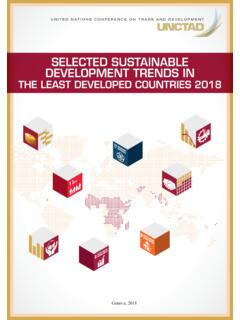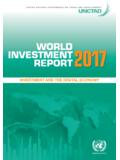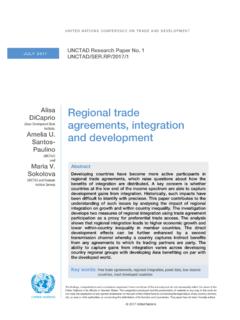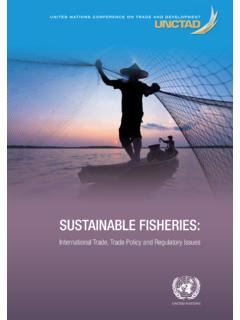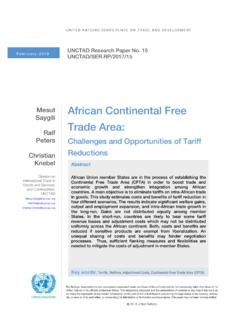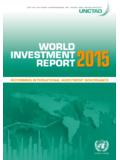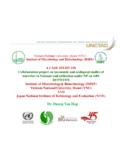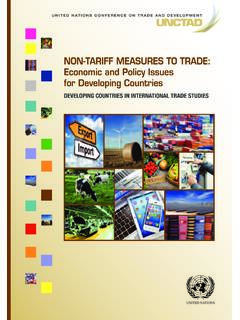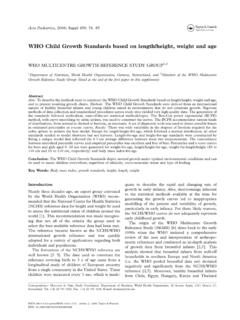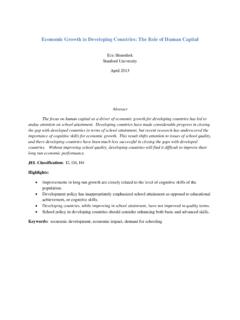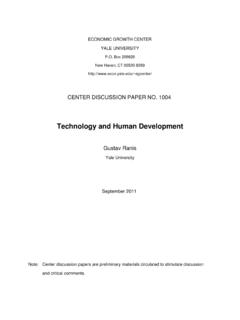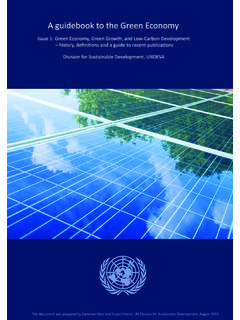Transcription of SPECIAL ECONOMIC ZONES - Home | UNCTAD
1 CHAPTER IV. SPECIAL . ECONOMIC . ZONES . INTRODUCTION. SPECIAL ECONOMIC ZONES (SEZs) geographically delimited areas within which governments facilitate industrial activity through fiscal and regulatory incentives and infrastructure support are widely used across most developing and many developed economies. Although the performance of many ZONES remains below expectations, failing either to attract significant investment or to generate ECONOMIC impact beyond their confines, new ZONES continue to be developed, as governments increasingly compete for internationally mobile industrial activity. Policymakers face not only the traditional challenges of making SEZs succeed, including the need for adequate strategic focus, regulatory and governance models, and investment promotion tools, but also new challenges brought about by the sustainable development imperative, the new industrial revolution and changing patterns of international production.
2 SEZs go by many names and come in many varieties and sizes. They have in common that, within a defined perimeter, they provide a regulatory regime for businesses and investors distinct from what normally applies in the broader national or subnational economy where they are established. The most common types of SEZs are variations on free ZONES , which are essentially separate customs territories. In addition to relief from customs duties and tariffs, most ZONES also offer fiscal incentives; business-friendly regulations with respect to land access, permits and licenses, or employment rules; and administrative streamlining and facilitation. Infrastructure support is another important feature, especially in developing countries where basic infrastructure for business outside these ZONES can be poor.
3 In return for these customs, fiscal and regulatory concessions; business-support measures; and investments in physical infrastructure, governments expect investors operating in SEZs to create jobs, boost exports, diversify the economy and build productive capacity. SEZs have a long history (figure ). The concept of freeports dates back many centuries, with traders operating off ships, moving cargoes and re-exporting goods with little or no interference from local authorities. Modern free ZONES , adjacent to seaports or airports or along border corridors, appeared in the 1960s. They began multiplying in the 1980s, with the spread of export-oriented industrial development strategies in many countries, especially in Asia, as well as the increasing reliance of global manufacturers on offshore production.
4 The acceleration of international production in the late 1990s and 2000s and the rapid growth of global value chains (GVCs) generated another wave of new SEZs, with many developing countries across all regions aiming to emulate the early success stories. Global trade rules limiting incentives linked to exports and the phasing out of exemptions to those rules for low-income countries were expected to curtail the growth of export processing ZONES (EPZs). Yet the trend barely slowed, as SEZ policies adapted to the new rules, while maintaining the basic offer to investors business-friendly environments with relief from customs and fiscal duties. The global financial crisis and the resulting dip in global trade only marginally slowed the establishment of new SEZs.
5 The current deceleration in globalization and international production is having the opposite effect, as governments are responding to greater competition for mobile industrial activity with more SEZs and new types of SEZs. There are nearly 5,400 SEZs today, more than 1,000 of which were established in the last five years. At least 500 more ZONES (approximately 10 per cent of the current total) have been announced and are expected to open in the coming years. The continued enthusiasm for SEZs among governments around the world belies the impact of these ZONES , which is often mixed. In developing economies that followed export- 128 World Investment Report 2019 SPECIAL ECONOMIC ZONES Figure Historical trend in SEZs (Numbers of countries and SEZs).
6 Number of economies with SEZs, selected years Number of SEZs 300 6 000. ~5 400. 250 5 000. 4300. 200 4 000. 3500. 150 3000 3 000. 147. 135. 130. 116. 100 2 000. 93. 73. 50 1 000. 47 845. 29 500. 79 176. 0 0. 1975 1986 1995 1997 2002 2006 2008 2014 2018. Source: UNCTAD . Note: The trend is indicative only. Historical estimates are based on ILO (2014) for 1975, 1986, 1995, 1997, 2002 and 2006; FIAS (2008) for 2008; The Economist (2015) for 2014; and UNCTAD for 2018. Scope and definitions of the various estimates across years may differ. oriented development strategies, there are many examples of highly successful SEZs that played a key role in industrial transformation.
7 But even in those economies, examples abound of ZONES that did not attract the anticipated influx of investors or did so only late. In latecomer countries, there are many more cases of ZONES that, once established by law, remained un- or underdeveloped for decades, and today's stock of SEZs includes many underutilized ZONES (figure ). Even where ZONES have successfully generated investment, jobs and exports, the benefits to the broader economy a key part of their rationale have often been hard to detect; many ZONES operate as enclaves, with few links to local suppliers and few spillovers. In addition to doubts about the ECONOMIC benefits of SEZs, the very concept of establishing a regulatory regime distinct from and in many respects laxer than the rest of the Level of utilization of SEZs according to national investment Figure promotion agencies (Percentage of survey respondents).
8 SEZs are fully utilized/occupied and 13. there is room for expansion/new SEZs SEZs are sufficiently utilized/occupied 22. SEZs are somewhat underutilized/vacant 25. SEZs are heavily underutilized/largely vacant 22. Source: UNCTAD Investment Promotion Agencies Survey. Note: The survey was conducted from February to April 2019. Results are based on information from 114 respondents. Chapter IV SPECIAL ECONOMIC ZONES 129. economy has raised concerns about social standards and labour conditions in EPZs, and about their environmental impact. Looser regulations have mostly focused on labour rules, including, for example, precarious employment arrangements and the discouragement of unions (although some studies also highlight the formal nature of jobs in SEZs and the often relatively high wages compared with those in the surrounding economy).
9 Even where there may not be formal exemptions from national rules such as those on health and safety, weaker controls and limited enforcement within the ZONES resulting from a desire to avoid disrupting businesses have often meant that standards within ZONES differed significantly from the rest of the economy. Despite these concerns, SEZs remain top of mind for industrial and investment policymakers, for a number of reasons. First, the relative ease of implementing business reforms through SEZs. In countries where governance is relatively weak and where the implementation of reforms nationwide is difficult, SEZs are often seen as the only feasible option, or as a first step.
10 Yet developing countries that have made progress towards more attractive investment climates also continue to rely on SEZs. When such progress fails to deliver better competitiveness rankings or expected foreign investment, SEZs may still be seen as a necessary complement to the investment promotion package and as a signal of the country's progress in building an attractive investment climate. Second, the perceived low cost of establishing SEZs. A key rationale for SEZs is their low cost in relative terms, compared with that of building equivalent industrial infrastructure in the entire economy. But even in absolute terms, the upfront investment costs can be contained.
